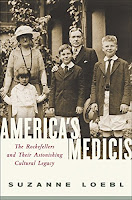The Medici legacy in Florence, Italy, stands across the ages as one of the most amazing periods of arts sponsorship known to history. The Rockefeller family may be recognized as equivalent to the Medicis as history provides a bit more distance on their contribution to art in the 20th century. The equivalence of the two families and how they preserved, celebrated, and educated around the arts is the subject of Suzanne Loebel’s America’s Medicis: The Rockefellers and Their Astonishing Cultural Legacy (2010).
In her introduction, Loeble remarks “the Rockefellers’ most important contribution was to teach America that art and its enjoyment, message, and healing power did not belong to a rarefied elite, but could be loved, understood, and even owned by all” (Introduction). Their advocacy ranged across different eras and places (e.g., Asian, Egypt, Mesopotamia, Palestine, American folk art, and Mexico), embraced diverse cultures, and included not only the visual arts of print and painting but impacted architecture as well. Examples of major collections include the Cloisters (NYC), Museum of Modern Art (NYC), the Oriental Institute (University of Chicago), the pristine island of Acadia National Park (Maine), and buildings such as Riverside Church (NYC), Rockefeller Center (NYC), Lincoln Center for the Performing Arts (NYC), the Fine Arts Museums of San Francisco, Nelson A. Rockefeller Empire State Mall (Albany, NY), and Kykuit (family mansion in Mount Pleasant, NY, now open as a sculpture garden and museum).
John D. Rockefeller, Sr. became the founding patriarch at age 16, forced to assume the “head of household” responsibilities when his father abandoned the family. Senior founded Standard Oil Company with a partner. Timed perfectly to take advantage of rising fuel demand in the late 19th century, he amassed a fortune that would be the base for the generations of Rockefellers to follow. Religion was central in Senior’s life, a staunch Baptist who taught Bible classes throughout his adult life and, along with his wife, Aby, believed in education, aiding the poor, and adhering to principles of thrift and humility.
John D. Rockefeller, Jr. adhered to the business advice and dictates of his father but rebelled to some degree against his mother’s conservative religious views. The rebellion did not stand in the way of Junior’s loyalty being expressed in the establishment of the University of Chicago as a Baptist university or the building of Riverside church in NYC. One of Junior’s greatest skills was identifying mentors and loyal collaborators who helped him achieve his ambitions. Frederick T. Gates became one of his greatest supporters and stewards of Rockefeller’s wealth. Regardless of the family’s commitment to philanthropy, the Rockefellers were included among the “robber barons” who were despised by many in the heady days of growing industrialization.
Senior and Junior sought to democratize art by bringing it to broad numbers of citizens. This inclination toward opening the arts to all is somewhat in contrast to the fact that both were enthusiasts of free and unrestricted trade and opposed unions. Their beliefs were immortalized in Junior’s personal creed, which was inscribed on the staircase leading to the Rockefeller Center ice skating rink:
I believe in the supreme worth of the individual and in his right to life, liberty, and the pursuit of happiness.
I believe that every right implies a responsibility; every opportunity, an obligation; every possession, a duty.
I believe in the dignity of labor, whether with head or hand; that the world owes no man a living but that it owes every man an opportunity to make a living.
Loebel’s book includes extensive detail on the collections of Senior, Junior, and other subsequent Rockefeller family members. Large portions of the family’s personal collections were donated to the museums that they either created or supported.
These Rockefeller collections are now on my new “bucket list” to see in the coming years. Clearly, a couple of weeks of touring Rockefeller museums would be an incredible treat. And, it would provide the opportunity to think about art as a catalyst for change, particularly art that is open and available to all, regardless of individual taste, preferences, and interpretation. After all, art is the visualization and symbolization of human experience. Exploring others’ views through art is a primary way by which we can build the bridges and relationships that we need for a thriving and sustainable world.

No comments:
Post a Comment